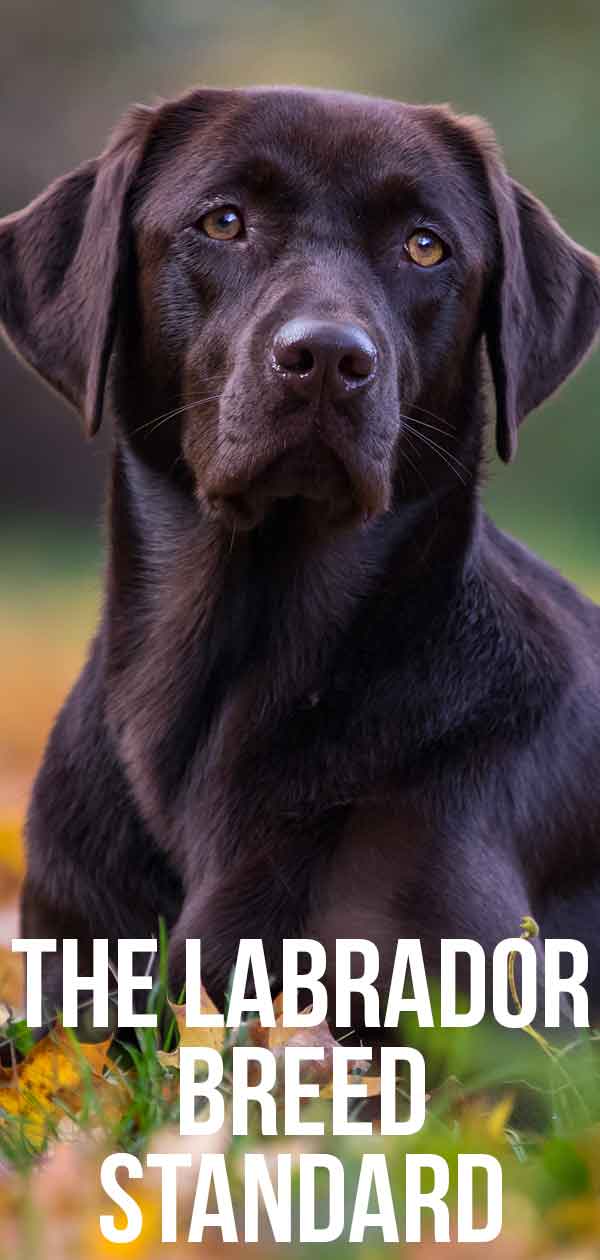The Labrador breed standard outlines the desired appearance of a purebred Labrador Retriever from head to tail. These standards are established by national clubs, which can vary slightly from country to country. While many Labradors may not perfectly meet every detail of the standard, it’s not a big deal. The Labrador Breed Standard This page explores who determines the Labrador breed standard, why these specifications are important, and how they differ across countries. We will delve into the “perfect” Labrador look and discuss whether it really matters if your Labrador deviates a bit. You can navigate through this menu for specific queries or read the entire article below. Frequently Asked Questions! What exactly is a breed standard? Who is responsible for setting the Labrador breed standard? Who oversees the operations of kennel clubs? Labrador Breed Standards in the USA Labrador Breed Standards in the UK Labrador Breed Standards in Australia Are breed standards beneficial? My Labrador doesn’t fit the standard criteria! The breed standard and its impact on selecting a puppy We will also examine whether adhering to the breed standard has positively or negatively affected Labradors as a whole. What Does a Breed Standard Entail? A breed standard comprises a set of criteria that describe the characteristics of a pedigree dog of a specific breed. It typically includes: Identification of the dog’s group, in the case of Labradors, it falls under the sporting dog category. Other groups include toy, utility, pastoral, working, and hound dogs. Overview of the breed’s appearance, traits, and temperament. Specific requirements regarding the dog’s anatomy and conformation. Guidelines on the dog’s movement and gait. Specifications regarding coat texture and color. The preferred size of an adult dog. These criteria serve as a benchmark for judging dogs in shows and heavily influence breeding decisions. But who establishes these standards? Who Sets the Labrador Breed Standard? The regulations for Labrador Retrievers and other pedigree dog breeds are determined by national kennel clubs such as the American Kennel Club and the United Kennel Club in the U.S., the Kennel Club and the Irish Kennel Club in Britain, the Canadian Kennel Club, and the Australian National Kennel Council. What Exactly is a Kennel Club? A kennel club is a charitable organization managed by a committee. These clubs aim to promote the objectives of their members and represent the interests of pedigree dog breeders. Each country has its own kennel club, and while the breed standards may be similar, they can differ slightly for each breed.

The Kennel Club, also known as The UK Kennel Club, was established in 1873 by thirteen individuals seeking consistent rules for dog shows and trials. In 1939, they acquired the renowned Crufts dog show as their main event. Their goals include promoting overall dog improvement, breed classification, and show judge approval. The American Kennel Club (AKC) was founded in 1884, following the footsteps of the British Kennel Club. Their mission is to advance purebred dog study, breeding, exhibition, racing, and care, along with upholding core values like promoting the purebred dog sport and safeguarding their Registry’s integrity. The Australian National Kennel Council (ANKC) was established in 1949 and officially organized under the ANKC name in 1958. Their mission is to encourage excellence in breeding, showing, trialing, obedience, and other dog-related activities, emphasizing the ownership of physically and temperamentally sound purebred dogs. Overall, all kennel clubs aim to uphold and promote ideal forms of purebred dogs. The committees and working parties within these organizations are responsible for reviewing and maintaining breed standards, typically comprising individuals with a deep involvement in dog breeding and exhibiting, along with specialist canine veterinarians.

Establishing the Standard for Labrador Retrievers Committees responsible for breed standards work towards defining the specific characteristics of each dog breed on behalf of their respective kennel clubs. This is a significant task as the breed standard significantly impacts breeders. Decisions regarding the breed standard can have implications on the appearance, abilities, and overall health of purebred dogs. Despite being established quite a while ago, many breed standards have seen little change over the years. Both The Kennel Club and the ANKC reissued their breed standards for Labrador Retrievers in 2018, whereas the AKC Labrador breed standard has remained in effect since 1994. Understanding Labrador Breed Standards What is the purpose behind these guidelines for the ideal Labrador Retriever? Initially, these standards were created to safeguard the exceptional working abilities of the breed. They were crafted by members of the hunting community, with functionality being of utmost importance. In today’s world, show communities play a more significant role in influencing kennel clubs, leading to a change in the purpose of modern breed standards. They now assist judges in awarding dogs that closely match the ideal Labrador concept, and also provide breeders with a benchmark to strive towards when making breeding decisions. What Makes the Perfect Labrador?

People often ask about how tall a Labrador should be or how much they should weigh, and while we explore these topics in our articles, breed standards cover almost every aspect of the perfect Labrador. Let’s delve into some of these standards. According to the AKC’s standard, a Labrador is described as a strong, medium-sized, athletic dog with the qualities of a working gundog and an all-around performer. The breed should have broad skulls, otter tails, and kind eyes. Labradors in the USA are expected to be 22 1/2 to 24 1/2 inches tall for males and 21 1/2 to 23 1/2 inches for females. In terms of weight, males should be between 65 to 80lbs, and females between 55 to 70lbs. Colors include black, yellow (ranging from light cream to fox red), and chocolate. Other colors may disqualify the dog from the show ring, but can still be registered. The UK standard describes Labradors as being strongly built, active, intelligent, and with good agility. The height guidelines are slightly lower than in the USA, with males at 22 to 22 1/2 inches and females at 21 1/2 to 22 inches. Weight is not specified, but there are guidelines on body proportions. Labrador breed standards are essential for maintaining the breed’s integrity over generations. While conforming to these standards is important for show dogs, it’s crucial for breeders to prioritize the health of their litters over strictly adhering to the standards. Genetic testing is becoming more common among kennel clubs to ensure healthier breeding practices. In the end, not meeting the breed standard may not be a big concern for most Labrador owners, as it mainly affects show ring success. As long as your Labrador is healthy and happy, that’s what truly matters.

Why Some Labradors Differ from the Breed Standard Many years ago, Labradors bred for work and for show were very similar. However, today, field and show lines of Labrador Retrievers have distinct differences. This means that even if your Labrador has a genuine pedigree, they may not meet the breed standard and could be mistaken for a mix breed. I have a fox red female Labrador from working lines who has a sleek body and a long, slender face. She doesn’t have the classic otter tail and her tail is carried too high. While she excels as a working dog, she wouldn’t fit in at a dog show. People often ask me what breed she is, despite her purebred lineage. So, comparing your Labrador to the breed standard won’t necessarily confirm their purity. When choosing a Labrador puppy, consider what your priorities are. If you plan to compete in field trials, look for puppies from successful working lines with field titles in their pedigree. For show purposes, choose descendants of show champions. It’s important to be cautious of breeders who may have strayed too far from the original Labrador standard. Some field lines lack the otter tail, while some show lines have exaggerated features that are not ideal for the breed as a whole. If you’re getting a Labrador as a pet and not for work or show, then the breed standard may not matter much. As long as the pup’s parents are healthy and have good temperaments, the breed standard becomes less significant. You can even choose a Labrador in a disqualified color or with unusual markings and love them for their unique traits. Ultimately, what matters most is that your Labrador is healthy and happy. When comparing your Lab to the breed standard, remember that it’s all in good fun. Share how your Lab measures up to the standard and consider if any changes should be made to the current standard. Let’s continue the conversation in the comments below!




